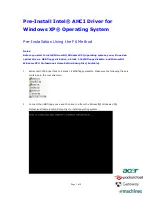
Intrusion Detection
149
Chapter 10
z
Sequence number analysis:
During an impersonation attack, the attacker will generally
spoof the MAC address of a client or AP. If two devices are active on the network with the
same MAC address, their 802.11 sequence numbers will not match – since the sequence
number is usually generated by the NIC firmware, even a custom driver will not generally
be able to modify these numbers. Sequence number analysis will detect possible imper-
sonation attacks by looking for anomalies between sequence numbers seen in frames in the
air.
z
AP Impersonation:
AP impersonation attacks can be done for several purposes, includ-
ing as a Man-In-the-Middle attack, as a rogue AP attempting to bypass detection, and as a
possible honeypot attack. In such an attack, the attacker sets up an AP that assumes the
BSSID and ESSID of a valid AP.
Signature Detection
Many WLAN intrusion and attack tools generate characteristic signatures that can be
detected by the Aruba network. The system comes pre-configured with several known
signatures, and also includes the ability for network managers to create and edit new sig-
natures. For more details on how to configure and create new signatures refer to the
Con-
figuring Signature detection
section.
WLAN Policies
z
Adhoc network detection/containment:
As far as network administrators are con-
cerned, ad-hoc wireless networks are uncontrolled. If they do not use encryption, they
may expose sensitive data to outside eavesdroppers. If a device is connected to a wired net-
work and has bridging enabled, an ad-hoc network may also function like a rogue AP.
Additionally, ad-hoc networks can expose client devices to viruses and other security vul-
nerabilities. For these reasons, many administrators choose to prohibit ad-hoc networks.
The Aruba system can perform both ad-hoc network detection and also disable ad-hoc
networks when they are found.
z
Wireless bridge detection:
Wireless bridges are normally used to connect multiple
buildings together. However, an attacker could place (or have an authorized person place)
a wireless bridge inside the network that would extend the corporate network somewhere
outside the building. Wireless bridges are somewhat different from rogue APs in that they
do not use beacons and have no concept of association. Most networks do not use bridges
– in these networks, the presence of a bridge is a signal that a security problem exists.
Summary of Contents for AirOS v2.3
Page 10: ...x Aruba AirOS Part 0500036 02 v2 3 User Guide January 2005...
Page 28: ...18 Aruba AirOS Part 0500036 02 v2 3 User Guide January 2005...
Page 42: ...32 Aruba AirOS Part 0500036 02 v2 3 User Guide January 2005...
Page 76: ...66 Aruba AirOS Part 0500036 02 v2 3 User Guide January 2005...
Page 92: ...82 Aruba AirOS Part 0500036 02 v2 3 User Guide January 2005...
Page 107: ...Configuring the Captive Portal 97 Chapter 7...
Page 136: ...126 Aruba AirOS Part 0500036 02 v2 3 User Guide January 2005...
Page 155: ...Configuring Virtual Private Networks 145 Chapter 9...
Page 156: ...146 Aruba AirOS Part 0500036 02 v2 3 User Guide January 2005...
Page 199: ...System and Network Management 189 Chapter 11 5 Click Done to make the modification...
Page 212: ...202 Aruba AirOS Part 0500036 02 v2 3 User Guide January 2005...
Page 246: ...236 Aruba AirOS Part 0500036 02 v2 3 User Guide January 2005...
Page 254: ...244 Aruba AirOS Part 0500036 02 v2 3 User Guide January 2005...
















































